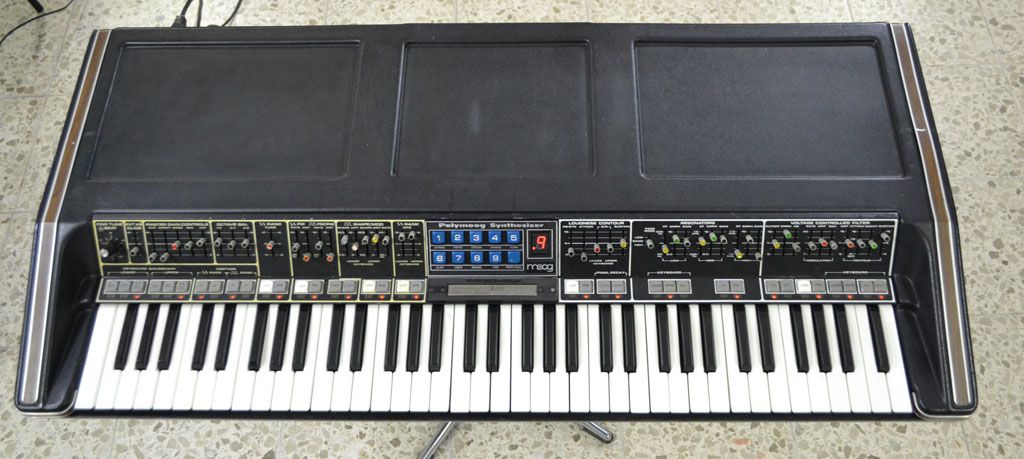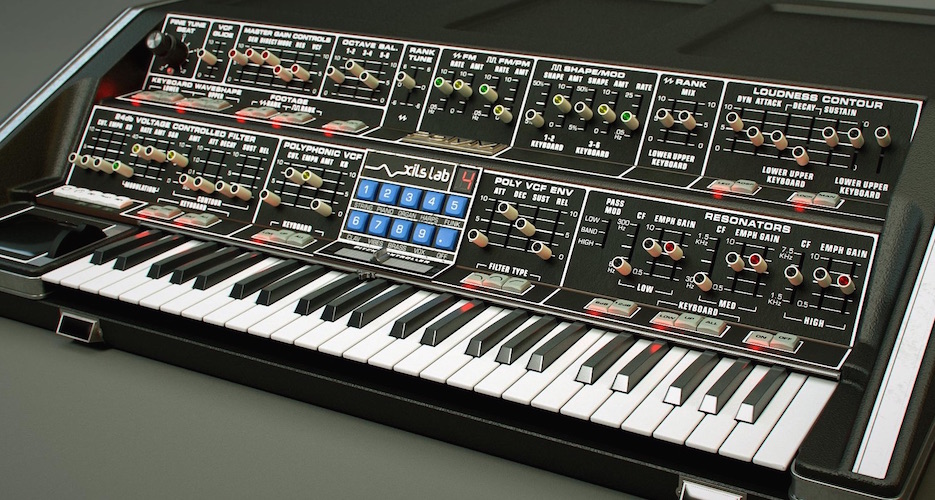As a part of the ambitious synth-ensemble system called The Constellation, the Moog Polymoog Synthesizer 203a was manufactured between 1975 to 1980. Based on divide-down oscillator technology—similar to electronic organs and string synthesizers of the time—its unlimited polyphony was considered groundbreaking when it was released.
Designed by Dave Luce at Moog Music (Bob Moog had very little to do with its design) the Polymoog is a polyphonic, preset-based, 71-key, velocity sensitive powerhouse, especially for the era, in which there weren't many polyphonic choices for synthesizers.

Released just a few years later in 1978, the Polymoog 280a built upon the 203a's eight presets, to include presets Vox Humana, Strings 2, Electric Piano, Honky Tonk Piano, Chorus Brass, and another Organ sound. Clocking in at around 82 pounds, the Polymoog's flat-top design was conceived for users to place another synth on top of, like the extremely popular Minimoog Model D.
Unlike other polyphonic synthesizers now being released into the market, such as the Yamaha CS-80, Sequential Circuits Prophet-5, and Oberheim OB-X, the Polymoog cannot store sounds programmed by the user or create each voice from individual oscillators. Because of these limitations, combined with its size, price, and temperamental nature, the Polymoog wasn't a commercial success, and production of the synth concluded in 1980.
Fast forward 28 years, and Grenoble, France's XILS-Lab—the brainchild of Xavier Oudin, a DSP maestro—has created an emulation of the Polymoog that builds on the functionality of the original unit. Having spent six years at Arturia developing products such as the Mini V, CS-80 V, ARP 2600V, and Prophet V, Oudin wanted to develop a line of software-based synthesizers outside of the scope of Arturia. Established in 2008, XILS-Lab first released the XILS 3, based on the EMS VCS3—the world's first integrated, portable synthesizer—and the Poly KB, based on the RSF PolyKobol 2.
After two years of development and released in 2017, the XILS-Lab PolyM built upon the beloved sonic character of the original Polymoog, adding a host of new features only available now through the power of digital signal processing and modern recallability.

For this Software Pick, we enlisted multi-instrumentalist, jazz funk maestro—and a key founder of the West Coast Deep House movement of the early '00s—CPEN, aka Chris Penny, to walk us through his process of writing an original piece of music using the XILS-Lab PolyM. Keep reading to hear straight from CPEN how he employed the software.
Gary Numan—having changed the face of pop music in the UK overnight, with his smash hit "Cars"—helped usher in electronic pop on a commercial scale in 1979. The string sound in that record is the Vox Humana patch from the Polymoog. He used this synth's character very liberally in the production of his album, The Pleasure Principle.
Blondie features the Polymoog phasey string sounds in the background of their hit single "Heart Of Glass," from 1978. Prince also featured the Polymoog on his first two albums For You and Prince, including his breakthrough single "I Wanna Be Your Lover." That late-'70s eerie, new-wave-esque iconic character this synth imbues is just sonic magic.
There is a certain sonic zeitgeist this machine achieves, one which can only be found in the patches and presets of the Moog Music Polymoog. If you wanted to buy one of these today, you'd be looking north of $4,000, if you can even find one—not to mention the regular visits to the synth doctor due to its unreliability. Fortunately, this sonic time capsule has been preserved and improved upon with the XILS-Lab PolyM.
For this demo track I wrote, "Poly Wanna Cracker," I used the XILS-Lab Poly M for all the sounds, except the drums. My background is rooted firmly in composition and performance—I am not a synth programming expert, by any means—but I found The PolyM quite easy to navigate, not requiring an in-depth knowledge of synthesis to get great sounding results extremely quickly.

The VCF Filter section and the nine different filter options (String, Piano, Organ, Harps, Funk, Clav, Vibes, Brass, and Vox ) are where I had the most fun, as it was fast and easy to shape the sounds with the Poly VCFs.

The Vintage Effects section adds a lot of subtle, unique character, including Reverb, Phaser, and Delay with many adjustable settings to preference.
This demo track is full of emotive brass pads, swelling strings, rhythmic plucks, and soaring leads, and you can really hear the analog nuances of XILS-Lab's sound emulations, thanks to their T.O.D. oscillators. For the poly-brass and string power-users, like myself, this is an irresistible sonic-coloring device in my arsenal.
Using factory presets as a departure point, and tweaking further from there, I came up with a nice variety of custom patches, which you can download for free, here: XILS-Lab PolyM | CPEN - Poly Wanna Cracker - Reverb Exclusive Presets.
Check out the demo track CPEN made below. Grab the free "Poly Wanna Cracker" Reverb exclusive presets, and get the the demo track for free with any purchase of the XILS-Lab PolyM Synthesizer.


